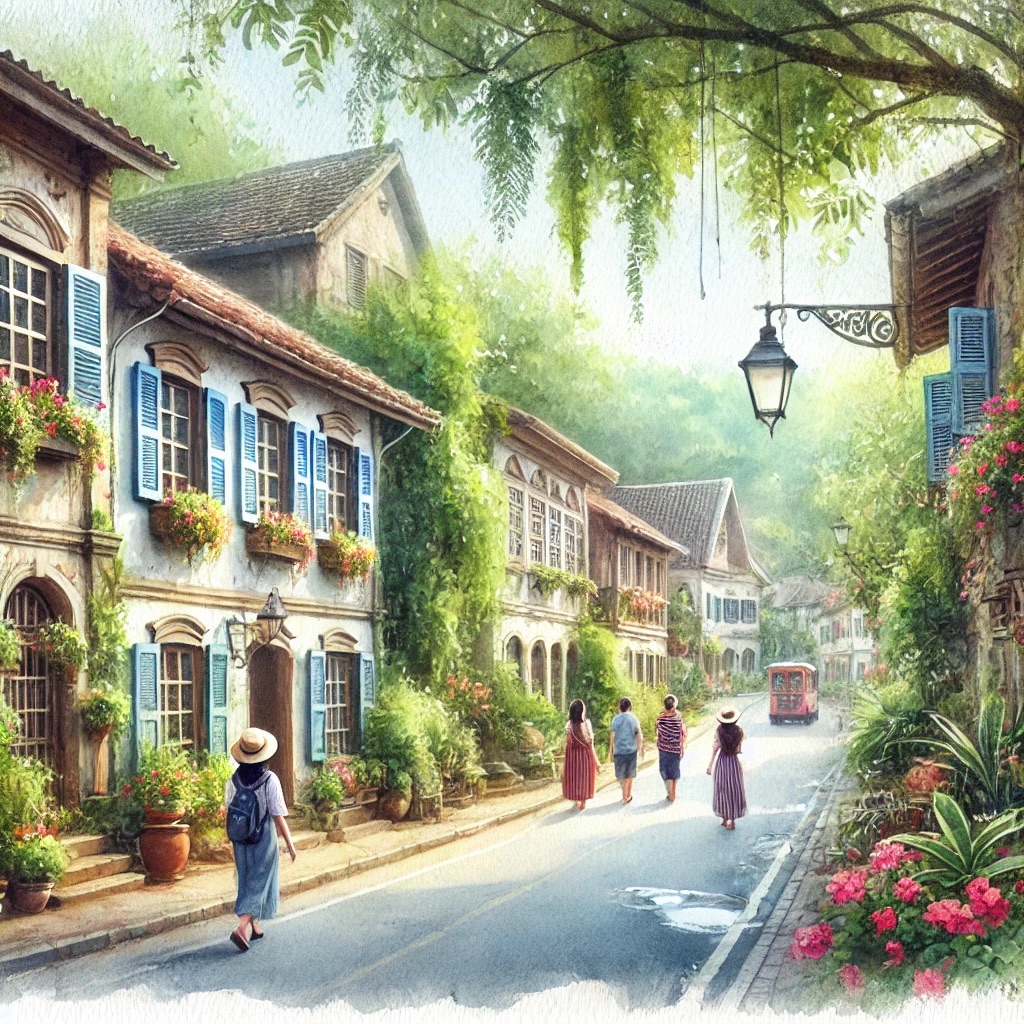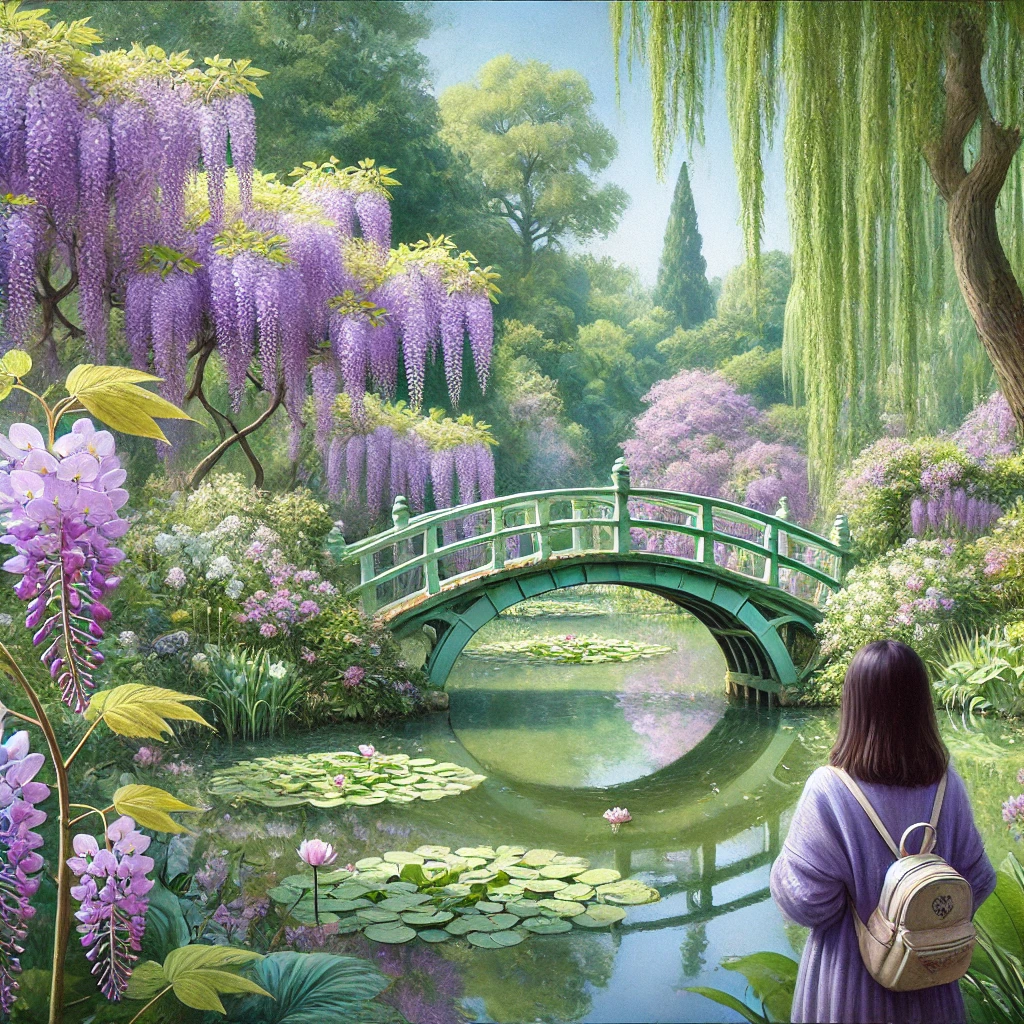ChatGPT:Giverny is a picturesque village in the Normandy region of northern France, known for its beautiful landscapes and as the former home of the renowned Impressionist painter Claude Monet.
Giverny also boasts a charming countryside setting with traditional French architecture, quaint streets, and a peaceful rural ambiance. It’s a popular destination for art enthusiasts and tourists, offering a glimpse into Monet’s life and the natural beauty that inspired his work. The Musée des Impressionnismes Giverny, located nearby, further explores the Impressionist movement and its connection to the region.
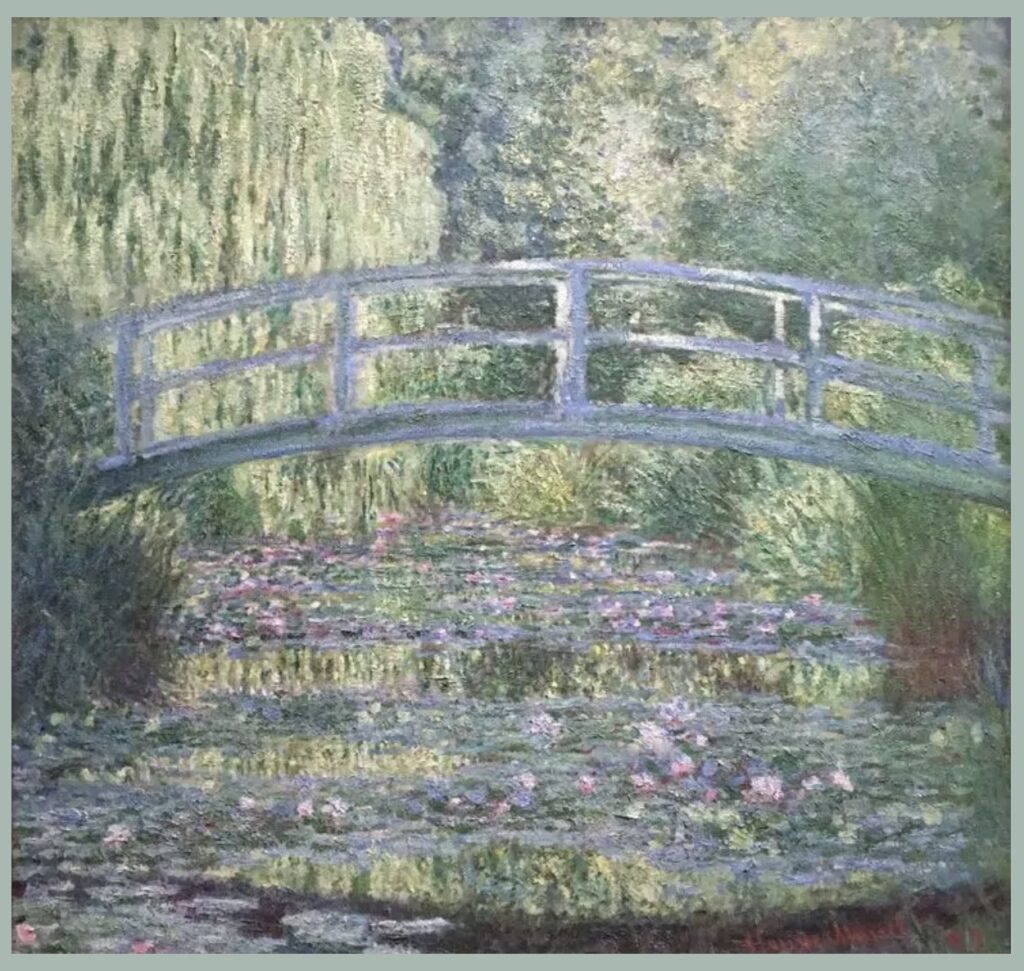
The gardens of Giverny, famously associated with Claude Monet, have a rich history tied to the artist’s life and work. Monet, a leading figure in the Impressionist movement, moved to Giverny in 1883 and lived there until his death in 1926. The village and its surrounding landscape provided a perfect setting for Monet, who had a deep love for nature and gardening.
Monet purchased the property and immediately began to transform the land surrounding his home into the gardens that would become so iconic. The gardens are divided into two main parts: the Clos Normand and the Water Garden.
- Clos Normand: This is the flower garden situated in front of Monet’s house. Monet arranged it in a seemingly informal style, yet with a careful eye for color harmony and plant variety. The garden is known for its vibrant, seasonal blooms and lush greenery. It features a mix of flowers, including roses, irises, and sunflowers, planted in beds and around trellises. Monet meticulously planned the garden’s design, ensuring that different plants would bloom successively throughout the year.
- Water Garden: Inspired by Japanese gardens, Monet created the Water Garden by diverting a nearby stream. This part of the garden is famous for its Japanese bridge, water lilies, weeping willows, and bamboo groves. Monet was particularly captivated by the interplay of light and water, which is reflected in his numerous paintings of the water lilies. The Water Garden offers a serene, reflective space, mirroring the beauty of the surrounding flora in the water.
Monet’s gardens were not just a hobby; they were an essential part of his artistic process. He often painted outdoors, capturing the changing light and colors throughout the day and seasons. The gardens at Giverny provided endless inspiration for his work, particularly his series of paintings focusing on the water lilies and Japanese bridge.
After Monet’s death, the gardens fell into disrepair. However, they were restored in the late 20th century by the Fondation Claude Monet, which now manages the property. Today, the gardens are a major attraction for visitors from around the world, offering a glimpse into the world that inspired one of the greatest Impressionist painters.
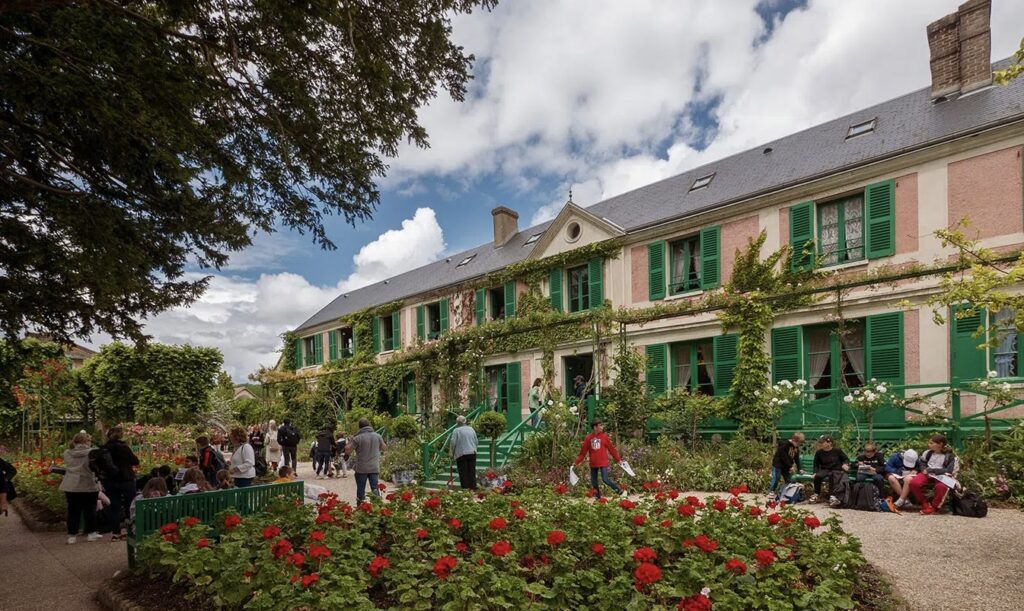
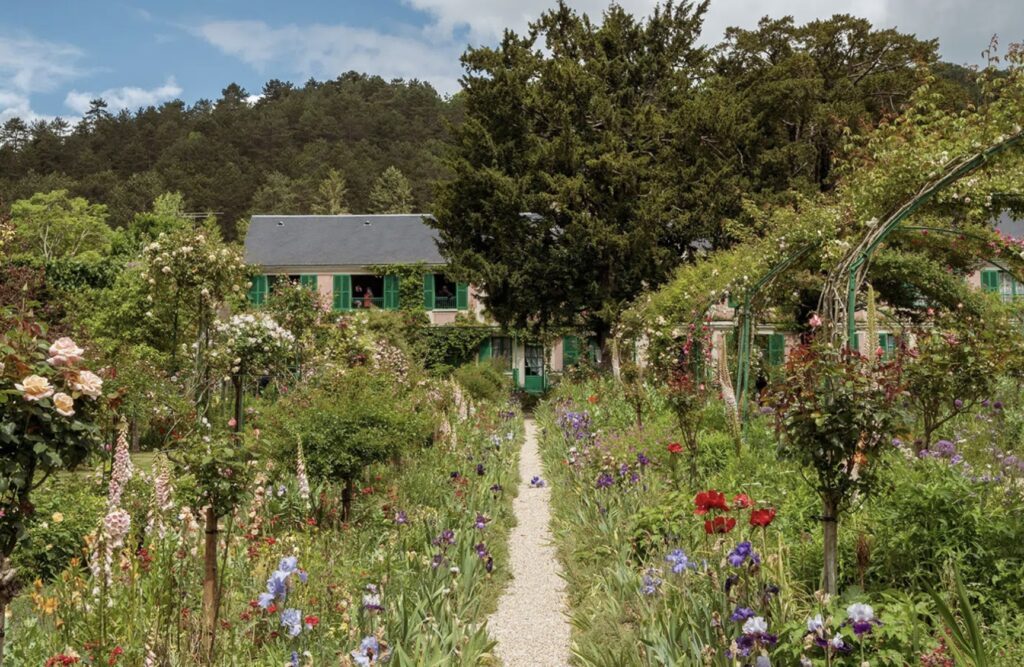
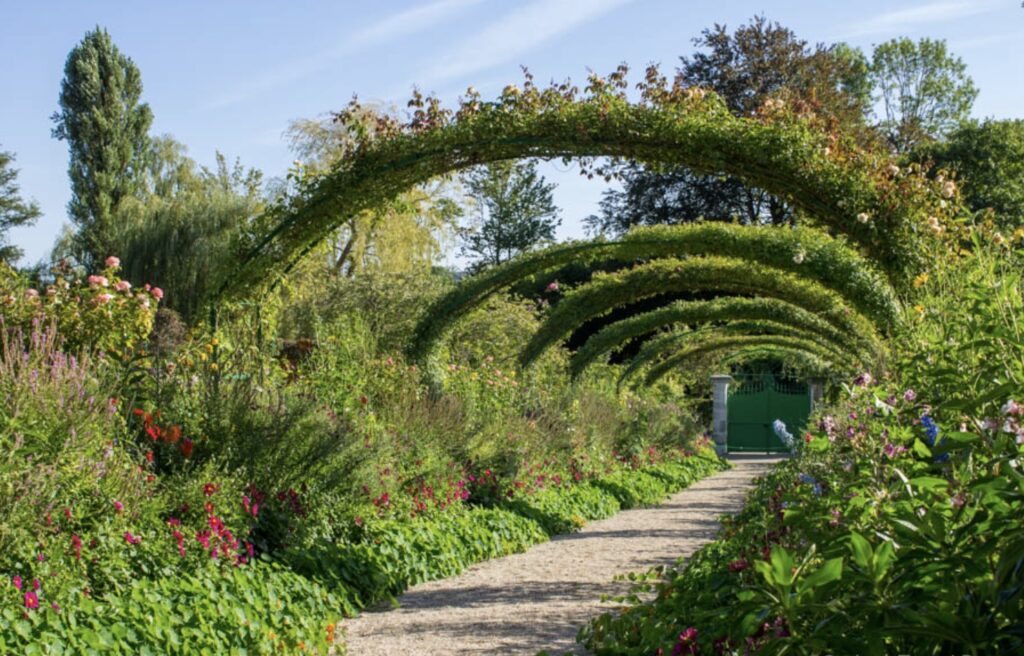
Claude Monet’s gardens at Giverny are rich with locations that inspired many of his most famous paintings. Here are some key sites and viewpoints within the gardens where Monet found inspiration:
- The Japanese Bridge: This iconic wooden bridge, painted green, spans the pond in the Water Garden. It is surrounded by willows, bamboo, and wisteria. Monet’s series of paintings featuring this bridge, often with water lilies floating beneath it, are among his most famous works.
- The Water Lily Pond: The pond itself, filled with water lilies, is a central feature of the Water Garden. Monet painted numerous canvases of the water lilies at different times of day and under various lighting conditions, capturing the reflections and the play of light on the water.
- The Grand Allée (Clos Normand): This central walkway in the flower garden (Clos Normand) is lined with arches of roses and other flowers. The vibrant, ever-changing blooms and colors provided Monet with endless inspiration. He painted several scenes of the pathway, showcasing the garden’s lushness.
- The Weeping Willows: These trees, located around the pond, often appear in Monet’s paintings. The soft, drooping branches create a reflective, tranquil atmosphere, which Monet captured beautifully in his works.
- The Iris Beds: In the Clos Normand, beds of irises in various colors bloom in spring. Monet was particularly fond of these flowers and frequently painted them. The irises, along with other flowers, are arranged in color harmonies that Monet carefully planned.
- The Water Garden Footpath: This path winds around the Water Garden, offering different perspectives of the pond, bridge, and surrounding vegetation. Monet used these changing viewpoints to explore different compositions and lighting in his paintings.
- The House and Studio Views: The views from Monet’s house and studio, particularly looking out over the garden, also inspired many paintings. These vantage points provided a higher perspective, capturing the layout and expanse of the gardens.
These locations within Monet’s gardens at Giverny are not only significant because of their natural beauty but also because they provided the inspiration for some of the most beloved works in the Impressionist canon. Visitors to Giverny can still experience these views, which have been carefully maintained to reflect the gardens as they were in Monet’s time.
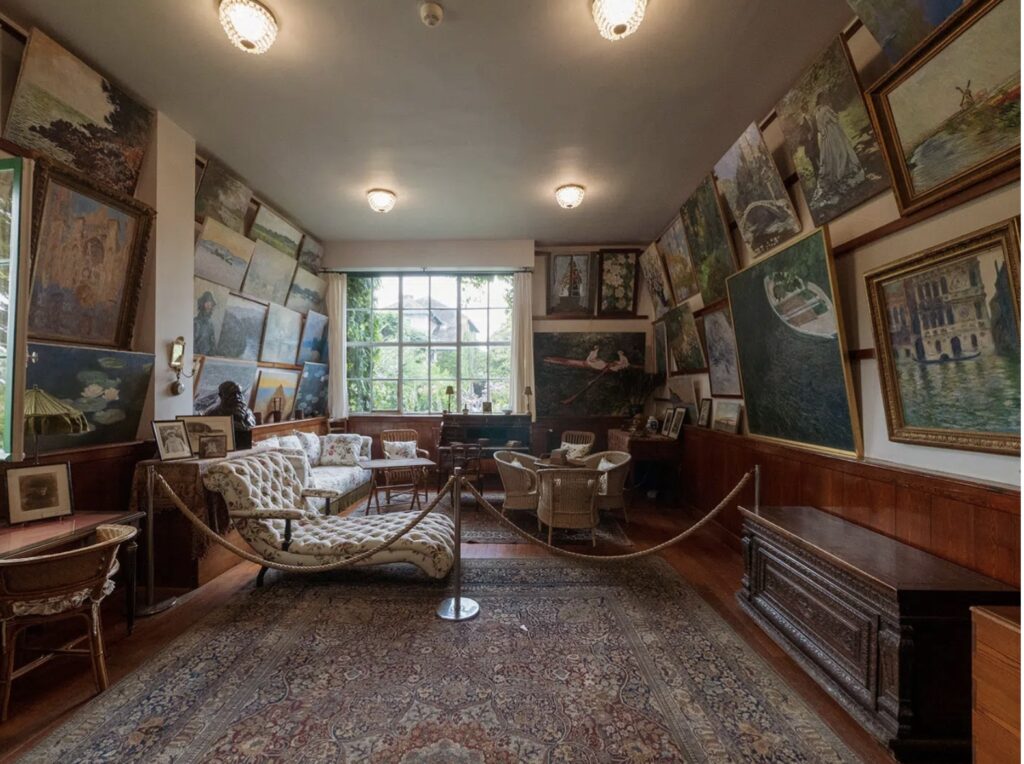
The gardens of Giverny, particularly Claude Monet’s house and gardens, are a highly popular destination for art lovers, gardening enthusiasts, and tourists from around the world.
Visitor Experience:
- Artistic Inspiration: Many visitors are drawn by the chance to see the real-life landscapes that inspired Monet’s masterpieces, especially the Water Lilies series. The gardens offer a living connection to the artist and his work, making the experience deeply enriching for art enthusiasts.
- Natural Beauty: The gardens are renowned for their vibrant, seasonal displays of flowers and lush vegetation. The meticulous design and maintenance of the gardens allow visitors to experience a variety of colors and scents, making each visit unique depending on the time of year.
- Tranquility and Reflection: The serene atmosphere, particularly in the Water Garden with its reflective pond and Japanese bridge, provides a peaceful retreat. Many visitors appreciate the tranquil environment as a place for relaxation and contemplation.
- Cultural and Historical Significance: The gardens are also a place of historical interest, offering insight into the life and work of Claude Monet. The house, with its preserved rooms and studio, gives visitors a glimpse into the artist’s daily life and creative process.
The experience of visiting Monet’s gardens is often described as stepping into a living painting, providing a unique and memorable experience for those who visit.
Monet’s gardens at Giverny are only open to the public from April to October. During this period, the gardens showcase a vibrant array of flowers that change with the seasons. Here’s a more focused view of the floral rotation within this open period:
April – May (Spring)
- Tulips: Early bloomers that come in a wide range of colors, creating stunning displays.
- Daffodils and Narcissi: Bright yellows and whites, marking the beginning of spring.
- Hyacinths: Fragrant and colorful, adding a delightful scent to the garden.
- Iris: Particularly bearded irises, which start blooming in late spring, providing a range of purples, blues, and whites.
- Forget-me-nots: Small, delicate blue flowers that often cover the ground in the Clos Normand.
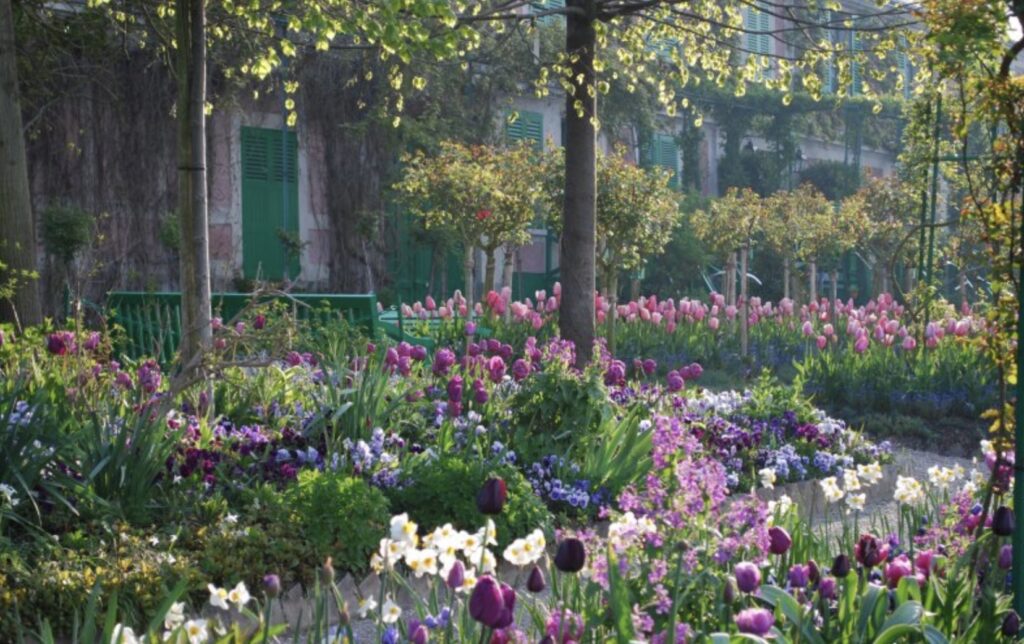
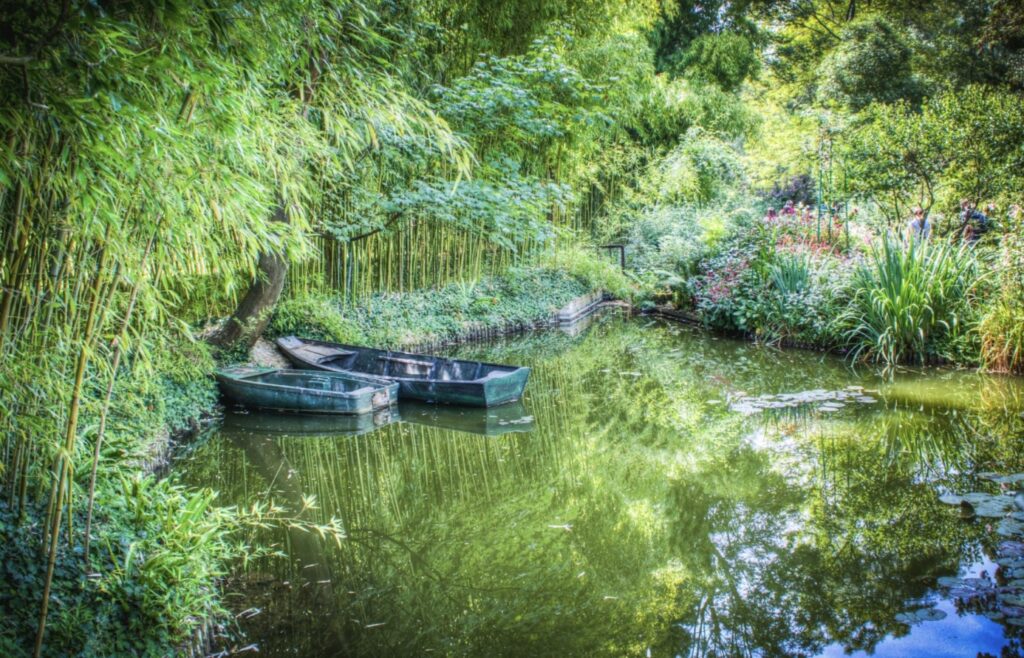
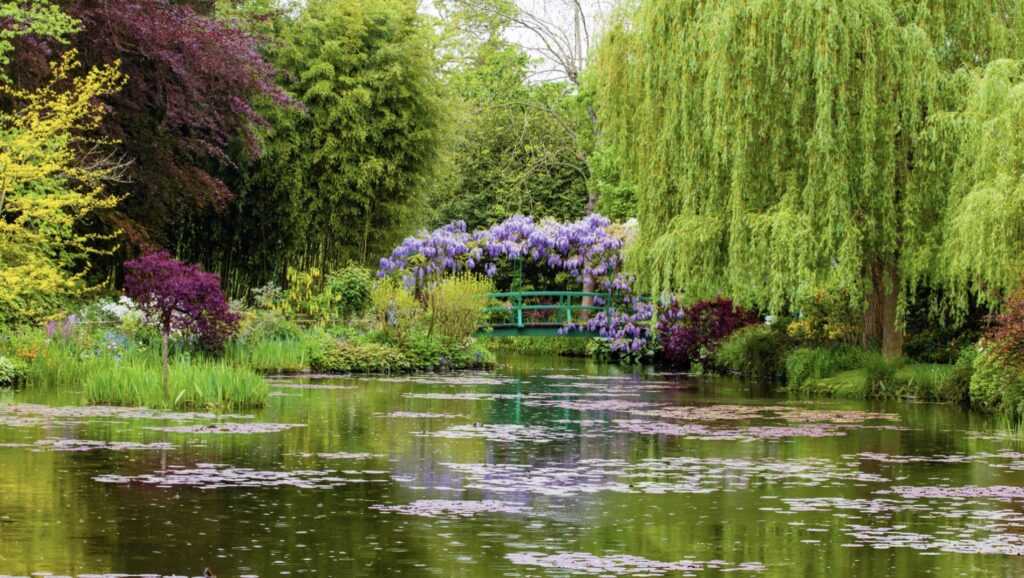
June – August (Summer)
- Roses: A variety of roses bloom throughout the summer, filling the garden with color and fragrance.
- Peonies: These lush, fragrant flowers add splashes of pink, red, and white.
- Lilies: Including Asiatic and Oriental lilies, known for their striking appearance.
- Poppies: These vibrant flowers, especially red poppies, are a summer highlight.
- Delphiniums and Foxgloves: Tall, elegant spikes of flowers, often seen in shades of blue, purple, and pink.
- Sunflowers: Known for their large, sunny faces, adding a bold statement to the garden.
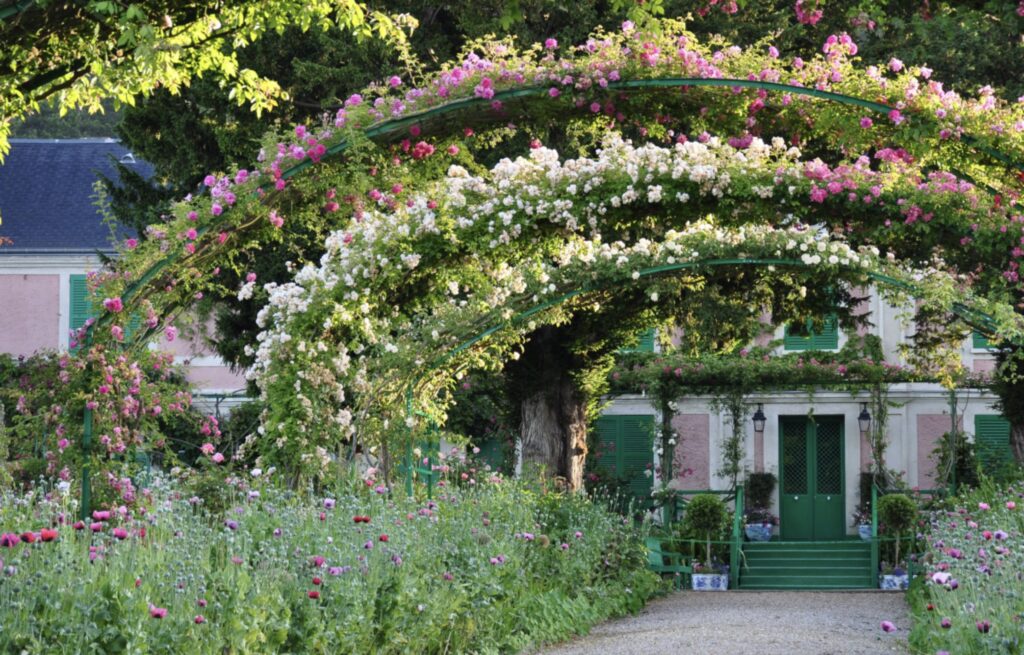
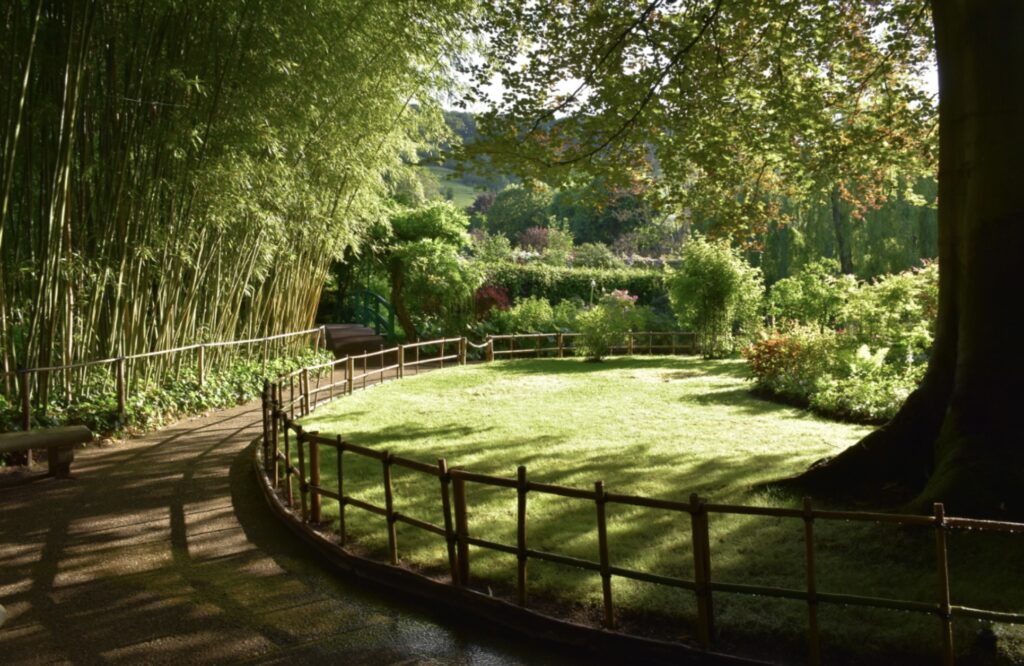
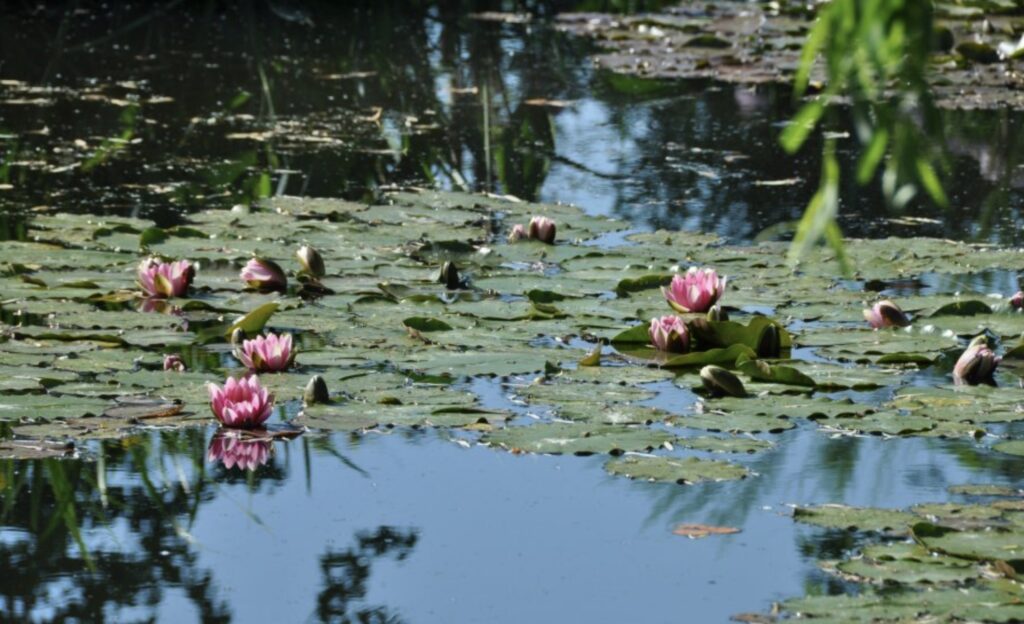
September – October (Autumn)
- Dahlias: With a wide range of shapes and colors, dahlias are a major feature in the autumn garden.
- Chrysanthemums: These flowers provide late-season color, ranging from whites and yellows to deep reds.
- Asters: Also known as Michaelmas daisies, they bloom in shades of purple, pink, and white.
- Japanese Anemones: Graceful flowers that add soft shades of pink and white to the garden.
- Sedums: Also called stonecrops, these provide texture and color, often with pinkish or reddish hues.
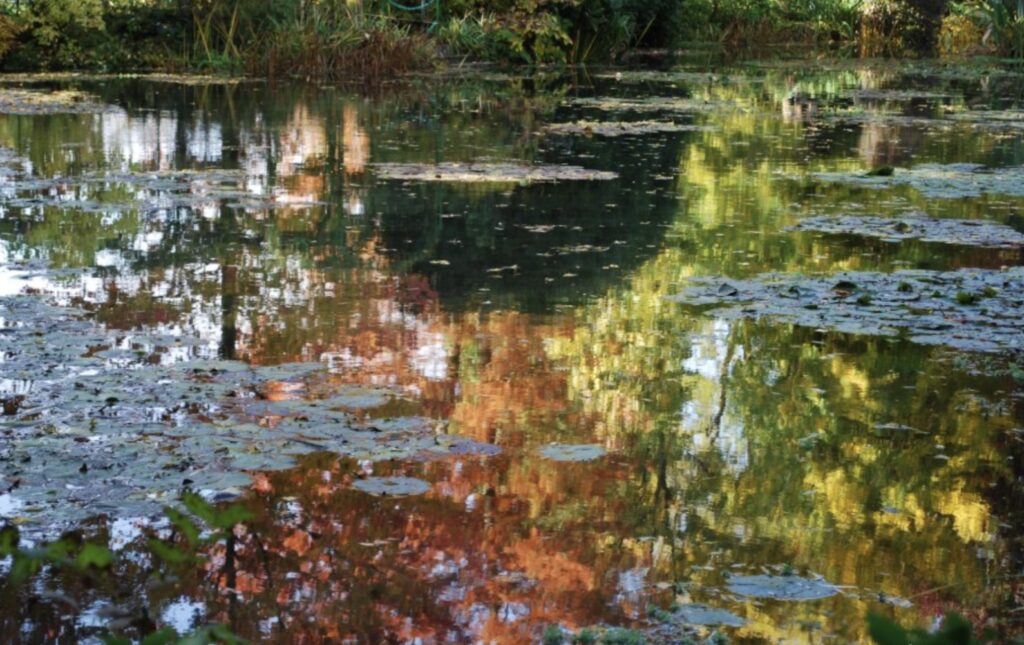
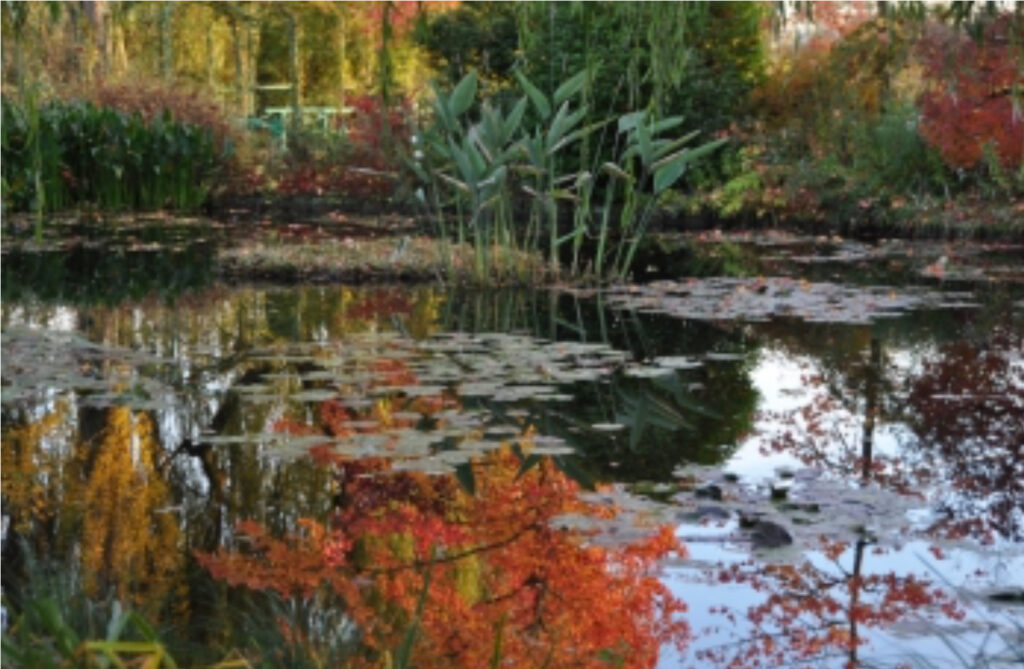
Throughout these months, the gardens are designed to have something blooming at all times, ensuring that visitors can experience a constantly changing palette of colors and scents.
Besides the famous gardens at Monet’s house, the village of Giverny offers several other interesting sights and attractions that capture the charm and cultural richness of the area:
- Musée des Impressionnismes Giverny: This museum is dedicated to the Impressionist movement, particularly focusing on its development and influence in Giverny and Normandy. It hosts a range of exhibitions, featuring works by Monet and his contemporaries, as well as later artists influenced by Impressionism. The museum also includes beautiful gardens and outdoor sculptures.
- Église Sainte-Radegonde de Giverny: This charming 11th-century Romanesque church is located near Monet’s house. The churchyard contains the graves of several notable figures, including Claude Monet and some of his family members. It’s a peaceful spot with historical and artistic significance.
- Ancien Hôtel Baudy (Baudy House): Once a famous inn and artist’s hangout, the Baudy House was frequented by many American and European painters who came to Giverny to work and study in the late 19th and early 20th centuries. Today, it operates as a restaurant, preserving its historical ambiance and offering a glimpse into the artistic community that flourished in Giverny during Monet’s time.
- Monet’s Former Studio and Workshop: Near his house, Monet had a second studio and workshop, which has been preserved. Visitors can see where he worked on his larger canvases, including his series of water lilies. This area provides further insight into his artistic process and life in Giverny.
- The House of Claude Monet’s Japanese Bridge: Located near the Water Garden, this small exhibition space provides additional information about the Japanese influences in Monet’s work and how they were integrated into the design of his garden.
- Le Jardin d’Eau (The Water Garden) and Surrounding Countryside: While the Water Garden itself is part of Monet’s estate, the surrounding countryside offers beautiful walks and views, capturing the idyllic rural charm that attracted Monet to Giverny. The landscape of fields, hills, and meadows adds to the scenic beauty of the area.
- Art Galleries and Boutiques: Giverny has several small art galleries and shops selling local crafts, artworks, and souvenirs. These establishments often feature works by local artists inspired by the Impressionist legacy of the village.
- Café Culture: There are quaint cafes and restaurants in Giverny where visitors can enjoy traditional French cuisine and local specialties. These spots are perfect for relaxing and enjoying the ambiance of the village.
These sights, along with the picturesque streets and traditional Norman architecture, make Giverny a charming and culturally rich destination beyond the famous gardens.
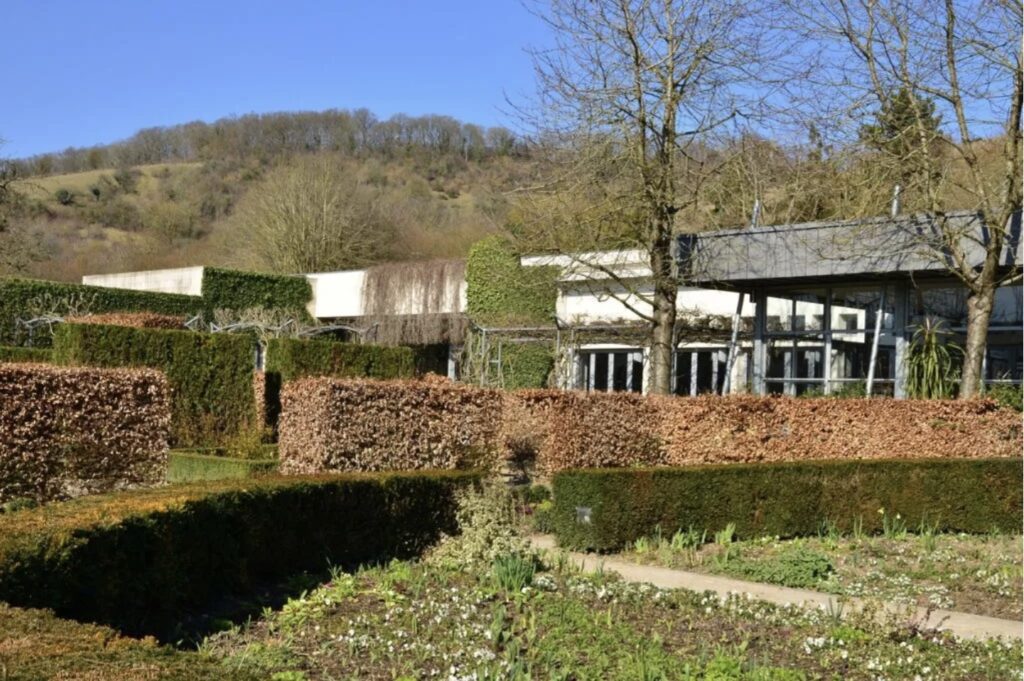
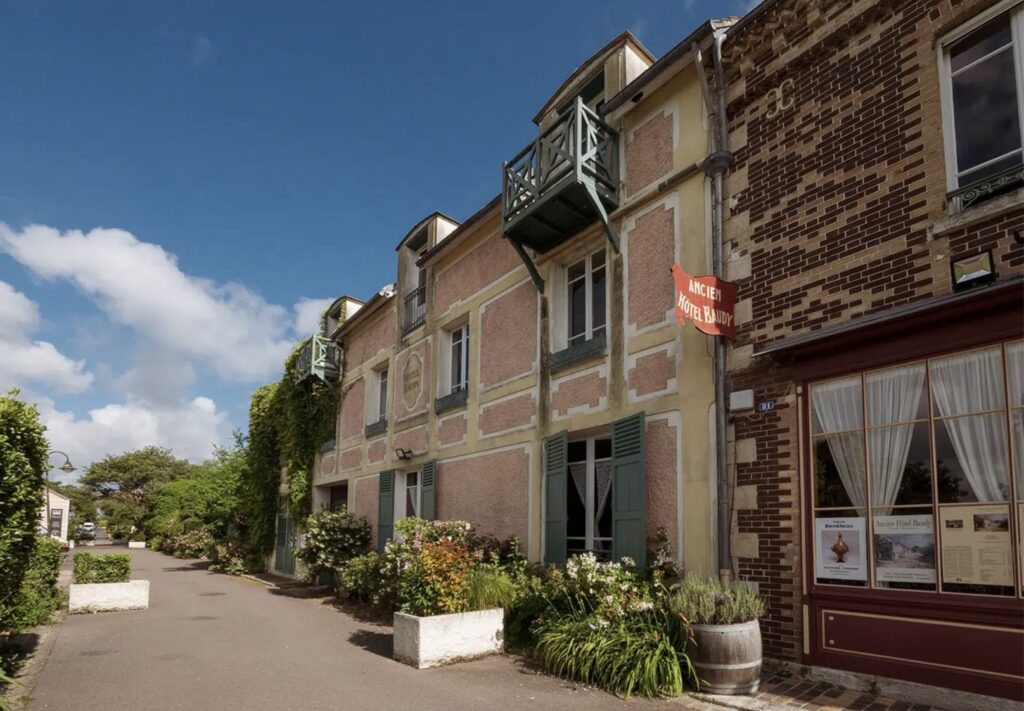
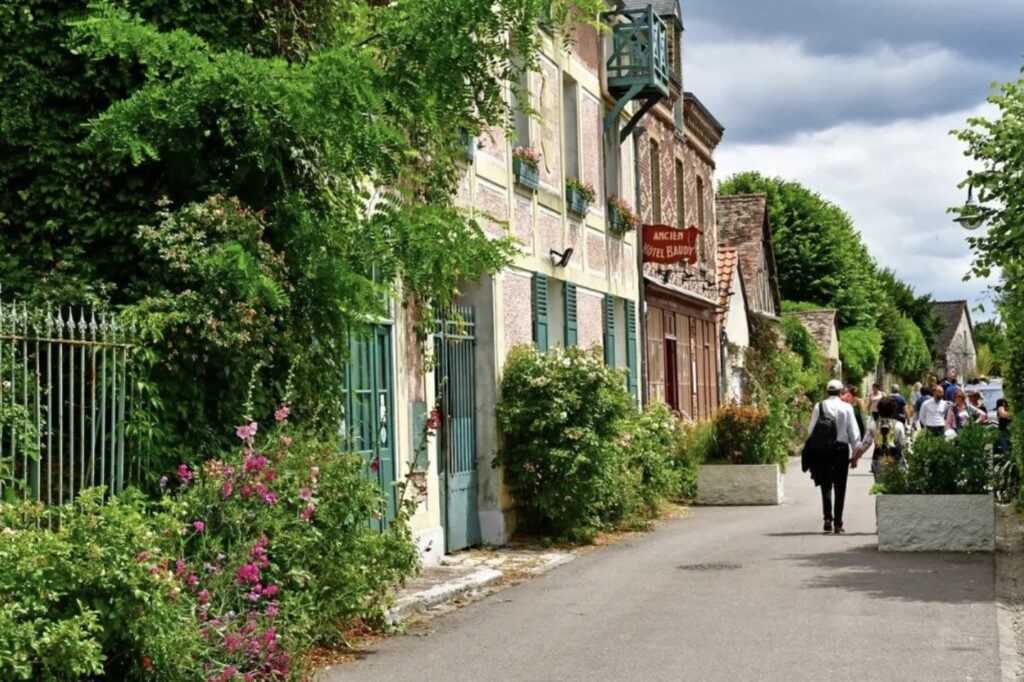
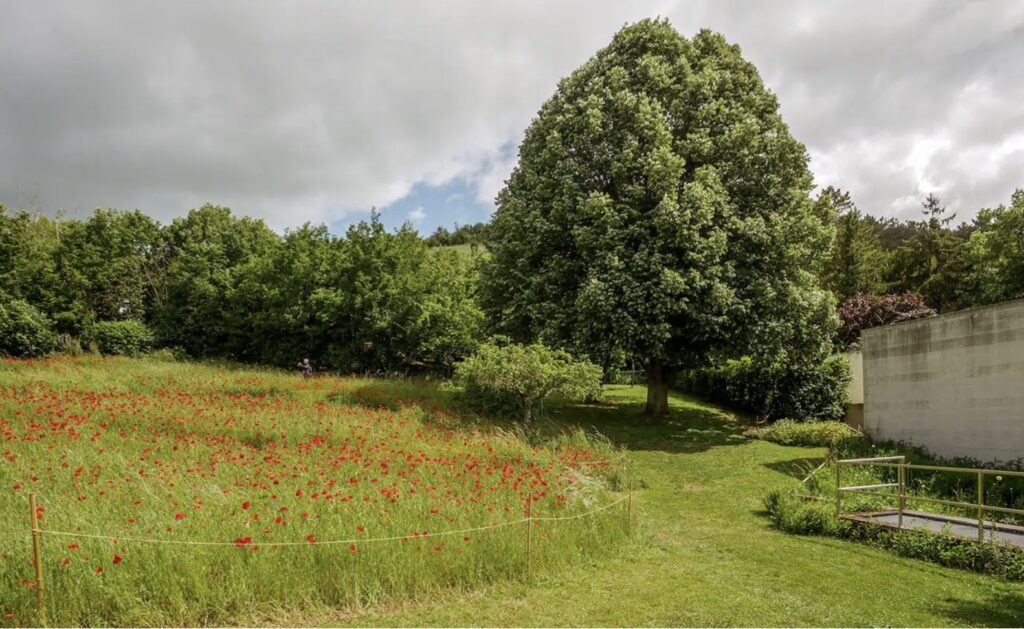
Here’s an itinerary for a day in Giverny.
Morning
1. Arrival and Breakfast:
- Start your day early in Giverny with a traditional French breakfast at a local café, such as Le Jardin des Plumes or La Capucine, enjoying croissants, pain au chocolat, fresh baguettes, and a café au lait or espresso.
2. Claude Monet’s House and Gardens:
- Visit Claude Monet’s House and Gardens, exploring the lush flower gardens and tranquil Water Garden with its iconic Japanese bridge and water lilies. Take your time to soak in the scenery and appreciate the inspiration behind Monet’s famous works.
Late Morning
3. Musée des Impressionnismes Giverny:
- Head to the Musée des Impressionnismes Giverny to enjoy its exhibits on Impressionist and post-Impressionist art, along with a stroll through the museum’s own garden.
Lunch
4. Lunch at Ancien Hôtel Baudy:
- For lunch, dine at Ancien Hôtel Baudy, where you can savor Normandy specialties like Poulet à la Normande or fresh seafood, and enjoy the ambiance of this historic artist’s haven.
Afternoon
5. Explore the Village of Giverny:
- After lunch, take a leisurely stroll around the village of Giverny. Visit the Église Sainte-Radegonde de Giverny to see Monet’s grave and explore the charming streets and houses.
6. Monet’s Former Studio and Workshop:
- Visit Monet’s former studio and workshop to see where he created many of his larger works. This is a great spot to learn more about his artistic techniques and processes.
Late Afternoon
7. Art Galleries and Boutiques:
- Explore the local art galleries and boutiques. Discover unique pieces inspired by the Impressionist movement and purchase souvenirs.
8. Coffee and Pastries:
- Enjoy a relaxing coffee break at a local café like Les Nymphéas, sampling delicious French pastries such as apple tarts or Tarte Tatin.
Evening
9. Scenic Walk or Drive:
- After the studio visit, take a scenic walk or drive around the surrounding countryside. Giverny is set in beautiful rural Normandy, with picturesque landscapes perfect for a leisurely stroll or a drive. You could explore nearby villages or simply enjoy the views of rolling hills and meadows.
10. Early Dinner at a Local Restaurant:
- Conclude your day with an early dinner at a local restaurant, such as Le Jardin des Plumes or another eatery in the area. Enjoy regional dishes like Coquilles Saint-Jacques (scallops), Camembert cheese, or Cider from Normandy.
11. Departure:
- After dinner, wrap up your visit and head back, filled with memories of the beautiful art and landscapes of Giverny.
This revised itinerary ensures that you experience the key attractions within their operating hours while still enjoying a rich and leisurely exploration of Giverny.
